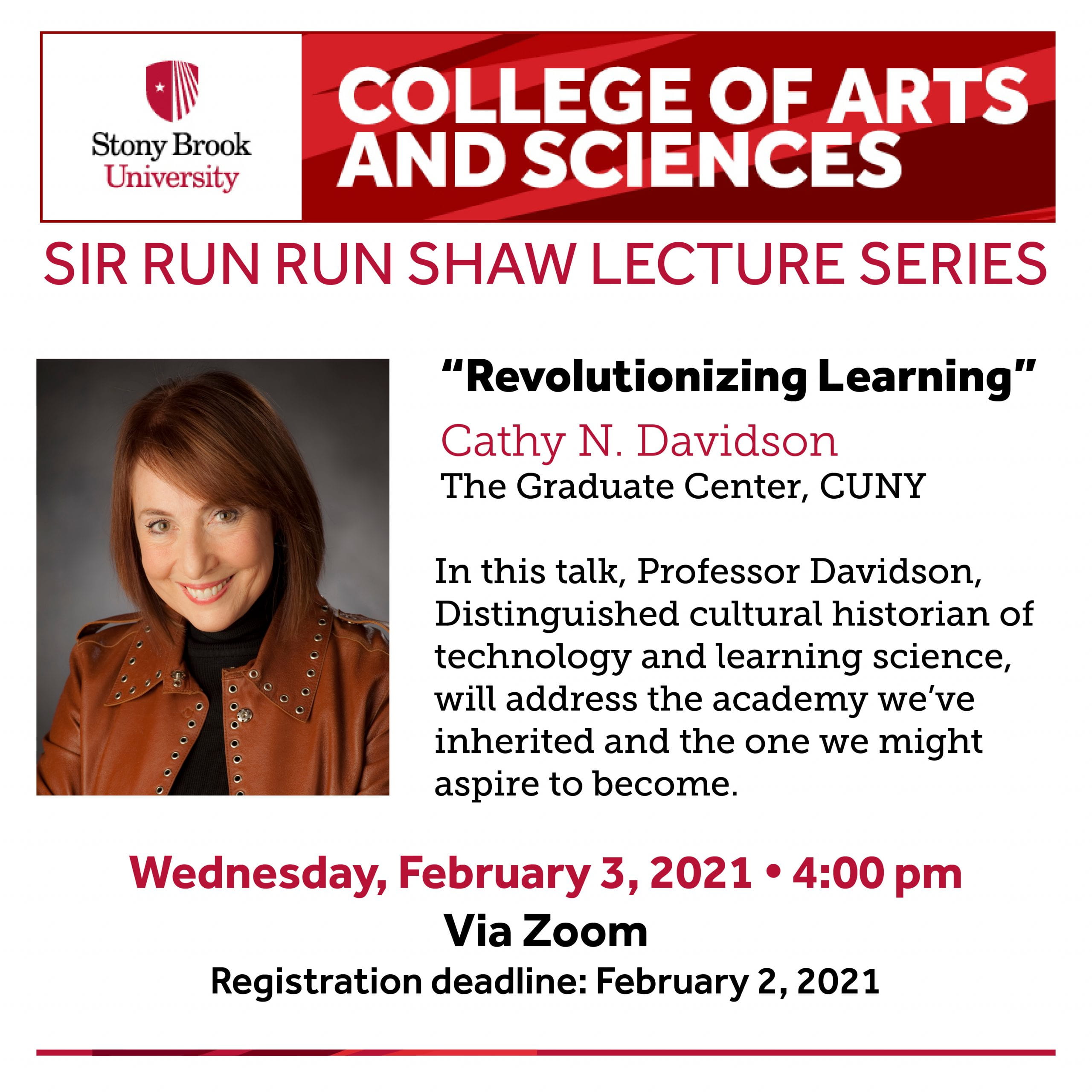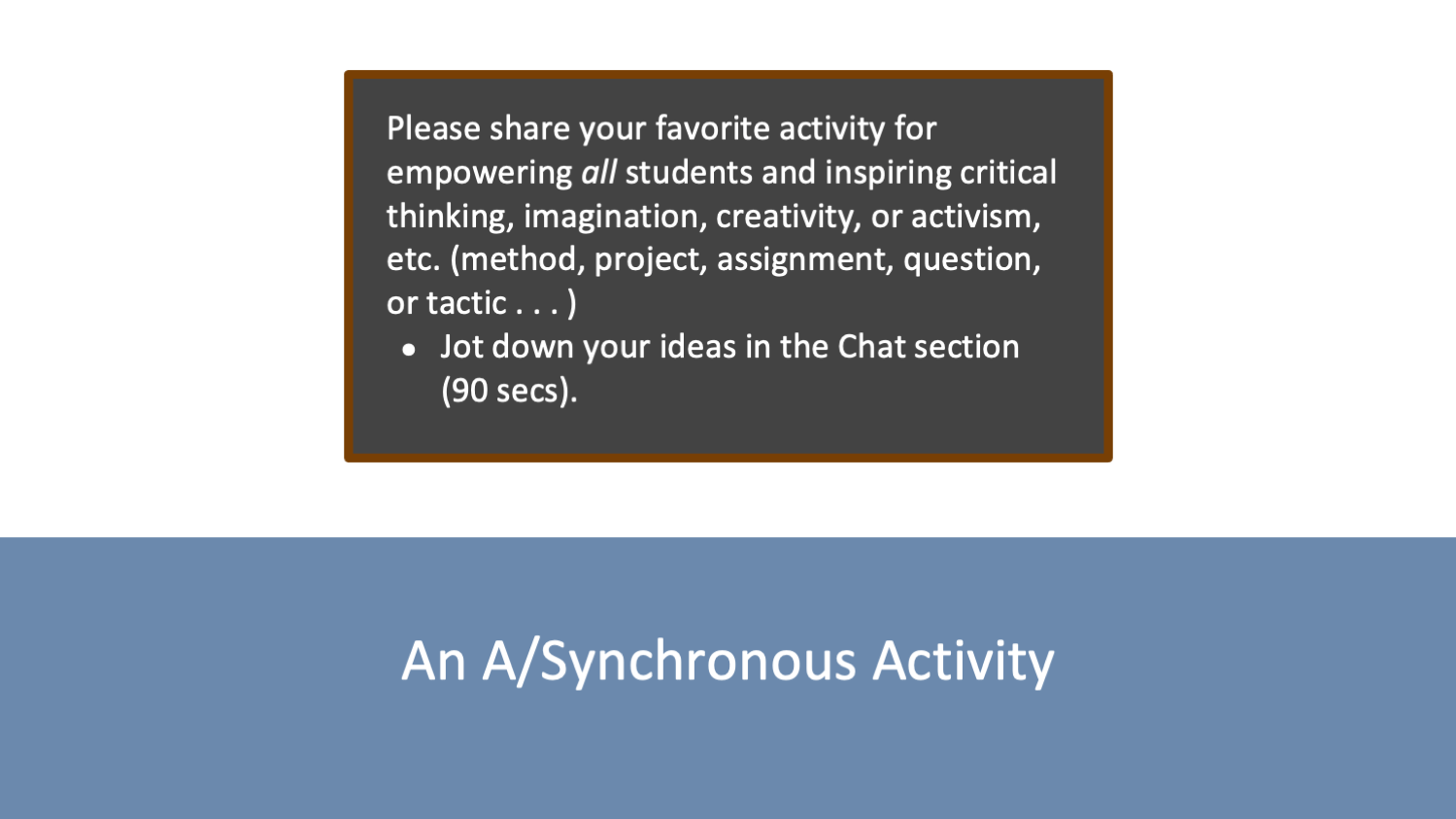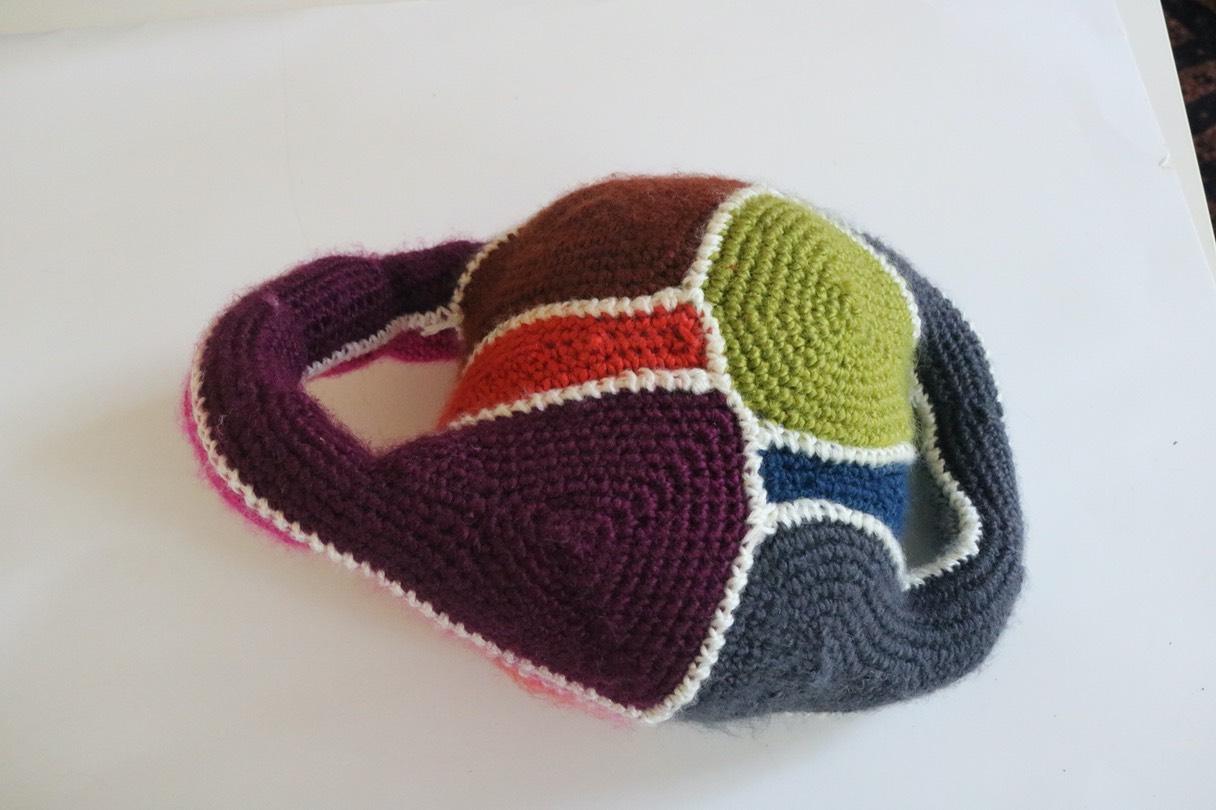Near the conclusion of her inspiring virtual Run Run Shaw lecture at the Humanities Institute on “Revolutionizing Learning,” Distinguished Professor Cathy N. Davidson (CUNY), asked the Zoom attendees to post in Chat their favorite class activities for “empowering all students.”
This 90-second activity was itself an example of transforming attendees into participants through active learning. The outcome was an instant crowd-sourced showcase of the diversity, creativity, and positive enthusiasm of the Stony Brook educators and guests who joined the talk.
1. writing and performing a play – Peg Spitzer
2. self-portrait, verbal or visual or audio. – Barbara Frank
3. I let the students choose what music to study. this semester I’m pairing them up each week to pick 2 pieces – one in the “canon” and one not. ( electronic music ) – Margaret Schedel
4. sharing family oral traditions – Andrew Newman
5. collecting favorite photos and writing a story about them – Peg Spitzer
6. crochet shapes to explain mathematical ideas (link) – Moira Chas
7. making a video in groups about their favorite chemistry application – Maria Nagan
8. handing out colored post it notes for students to write 6 word memoirs and post on the blackboard for everyone else to read – Patricia Medved
9. Use a short story/fable to illustrate/question an aspect of the topic du jour – Vabid Masrour
10. Having them work up a script to incorporate some piece of the lesson topic into an episode of their favorite television show – Jinx Mylo
11. Pitching a vampire film-casting, plot summary, moldboard, soundtrack-for a film class – Jessica Hautsch
12. Asked students to create something (a drawing, letter, paragraph) to explain an argument to the opposing side. Got great pictures AND many “aha” moments before we rewrote thesis statements. – Janice Willson
13. Invite students to say 5- 7 things that they can see/hear/touch/smell from where they are sitting – this is to invite the material world into the digital – Sofia Ahlberg
14. Everyone designing a thematized gallery tour of an art show we studied together – Sohl Lee
15. I work with students to create a collaborate community charter.. everyone adds a learning action/behavior that foregrounds respect, reciprocity, compassion, and care. – Kristina Lucenko
16. break students into groups: they select a passage or passages, which they discuss, analyze and then present to the class – Justin Johnston
17. I teach pedagogy and I have started creating compendiums of the best exercises of all my students which future students get to pour over – Sarah Stein Lubrano
18. For my dystopian narratives class, I asked students to write what dystopia means now. – Nerissa Balce
19. Annotation as visual method. I did this first in a comics class, but I use it now in all of my classes. – Lisa Diedrich
20. For my Before ‘Black Lives Matter’ archival class we choose images (maps, scenic paintings, portraits) and pool them then each chooses an image that becomes our screen background. We each talk about where we understand ourselves to be in relation to that history. Sometimes we all have the same map. Then…Wow! – Yvette Christianse
21. Book making day! Teaching Shakespeare, we do a day on folding quartos/octavos to learn about print history. Students love it. – Eileen Sperry
22. critical for active learning: always learn the names of every student in your class, even if there are 150 in there, within the first 2 weeks—then with each new point that a student makes, build the student’s name into the nomenclature of that point. Learning names and given ample, apt credit is massive – Andy Flescher
23. Team of grad students imagining the university of 2035 – Eric Wertheimer
24. I teach marketing analytics–every student has to create a data visualization without electronic aid that displays data related to some aspect of their lives–e.g. the shoes they own, the movies they watched this month, etc. – Ann Veeck
25. I’ve had a really fun time with a social media activity, where I ask students to live tweet/ create an IG post/series of FB statuses for a character whose POV isn’t represented in a scene in the book we’re reading – Julia Brown
26. we draw group pictures together on whiteboard and also do portraits in breakout rooms – Marta Baumiller
27. self-portrait with theory and photographs – Victoria Hesford
28. Giving each student a character in the Shakespeare play and asking them to create a Twitter identity. They have to retweet, choose who to follow, respond to other characters, etc. – Amy Cook
29. I have students “pass it on,” when we are analyzing difficult texts; they may pass it on to another student they know or do not know. It gets everyone to speak in class and on Zoom. – Mary Jo Bona
30. I spend time discussing the news of the day, slightly related to the topic of the day, the students love to challenge each other – Norman Edelman
31. I had students annotate the course syllabus this semester as a way to ensure they know what to expect from the class AND to make any changes to the course depending on students’ feedback – Jon Heggestad
32. writing a collaborative reading journal on google docs – Sindija Franzetti
33. working in small groups to draw or visualize a concept from feminist theory – Liz Montegary
34. Have students choose their most memorable scenes from one or several of the films we see in our cinema course and think about how these scenes could make a new movie, a new story. – Adrián Perez Melgosa
35. ink shredding: each student answers a question on a sheet of paper. After a couple of minutes, they pass the paper back. The next student can engage with what’s written on the sheet, expand on it, or argue with it. Do this three or four times and then ask students to share with the whole class. Students can share whatever is on the sheet in front of them–it doesn’t have to be their idea. – Celia Marshik
36. I teach students how to draw inferences by taking everything out of my pockets and asking the students to take notes. Afterward, all the students note what they noticed and draw inferences about me. The variety of what they noticed and what they inferred is incredibly thought-provoking. – Gene Hammond
37. song of myself, video projects in Phoenix, AZ – Eric Wertheimer
38. Ask students to pick a sentence or short passage from a text we are studying. Everyone reads aloud, even repetitions. The result is rich and sometimes disconcerting. Then we discuss what we heard. – Brian McAuliffe
39. Using tossable pillow microphone in large lecture, throw to student to answer a question then that student chooses to toss to another student either to elaborate on same question or to answer a new question that comes to the student ‘s mind – Susan Scheckel
40. 1st day word clouds – Sarah Jourdain
41. Reflect/Move/Connect: a class period long activity. First pose several reflective questions about their experiences of diversity in their lives. Then we move outside to position our bodies in space relative to our lived experience of diversity as well as our comfort in discussing such topics on two axes-then we return in small groups of like and unlike experiences to talk about our thoughts. – David Syring
42. activity based on André Breton’s “Le cadavre exquis” – aka the “write-fold-pass” sentence/story builder. Everybody writes the first word of a sentence or first sentence in the story (you give some guidelines– ie. “noun” or “Once upon a time…”) then passes their first word/line to another student, who writes the 2nd one, and so on. I’ve done it in French classes to write collaborative fairy tales. It’s so much fun! – Sarah Jourdain






Great post, very useful.
شركة تنظيف خزانات بالرياض
If you are a computer programmer, you should learn https://www.stormrisk.org/how-to-make-scratch-games/ how to make a good scratch game. You can start by writing a basic code that controls the main character, called the Scratch cat. Then, you can add more features to the character by adding more codes. As you build the game, you’ll probably need to add more blocks and code for the main character as it moves. You can also add a backdrop to the Scratch editor near the Sprite menu.
검증된 업체 먹튀검증 최고의 메이져